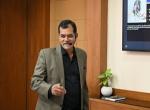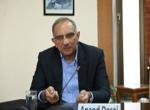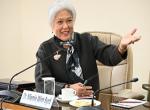A special edition of Vimarsh was organized on Political Stability and Transformation of Union Budget at the Vivekananda International Foundation on February 15, 2020. The public event which marked the launch of the newly set-up VIF Centre for Economic Studies, brought together an eminent panel comprising of Sh. S. Gurumurthy, Chairman, VIF; Member of Parliament [RS] Sh. Rajeev Chandrashekhar, Vice Chairman, Centre for Economic Studies; Ambassador Prabhat P. Shukla, Distinguished Fellow, VIF and Dr. Arvind Gupta, Director, VIF.
Dr. Gupta in his welcome address briefly focused on the recently released Union Budget 2020, and the crucial need to revive economic growth in the country for strengthening national security. A silent condolence was offered to Sh. P. Parmeswaran, Chairman, Vivekananda Kendra who passed away on February 9, 2020.
Rajya Sabha MP and member of parliamentary consultative committee on finance, Sh. Chandrashekhar drew a correlation between political stability and economic growth in his presentation. He put forth a comparative analysis of economic trends in the country spanning over the past few decades. He divided the timeline of India’s post-independence economic history into four broad phases based on political leadership, i.e. : (i) strong leader, single party government [2014 onwards]; (ii) strong leader, weak coalition government [1991-1996; 1999-2004]; (iii) weak leader, coalition government [2004-2009, 2009-2014] and (iv) weak leader, unstable coalition [pre-1991, pre-1999]
The data highlighted how decades of weak leadership and governance instability had a negative drag on the Indian economy, impacting key macroeconomic variables including GDP growth, investments, government finances, current account balance, and inflation. Political instability not only shortens policymakers’ horizons leading to fiscally imprudent populism, but the ensuing policy uncertainty adversely impacts investor confidence and macroeconomic performance. The structural reforms and decisive policy actions required to yield economic growth remained missing during phases of weak unstable governments, and considerably retarded India’s rise.
As a corollary, he also posited that it is the politically stable and strong leadership at the centre since 2014 that has addressed these legacy issues, re-building a broken and lagging economy to now making it the fifth largest globally. The Economy in 2014 was in doom with an average inflation of 10%, a fiscal deficit of 5.3% and, on the brink of a full blown current account crisis with CAD at 4.7% of GDP. The Government debt as percent of Nominal GDP amounted to 50% in 2013, which has been brought down to 44% in 2019. India witnessed deadly combination of low growth and high inflation. Its external debt has come down to 19% of GDP in 2019, from 23.8% of GDP in 2013. Investors were fleeing the country and the country lagged at 150th position on the World Bank’s Ease of Doing Business Index in 2014. Poor governance of public sector banks and profligate lending during the 2004-14 period resulted in a mammoth NPA-crises that has so far cost the exchequer a whopping Rs.3.8 lakh crores in recapitalization, he added.
In the six years since, the Modi-government has undertaken a slew of governance and structural reforms to cleanup and rebuild the economy. These range from implementation of GST, reduction in corporate tax regime, formalization and digitization to plug leaks in the financial system, to undertaking several efforts towards public-sector bank recapitalization and restructuring for mitigating the mega NPA crisis left by the UPA government. The impact of these is evident in stable macroeconomic fundamentals and improved domestic business environment yielding increased inward FDI levels. Additionally, the behavioural impact of these reforms has been manifold resulting in a reduction in corruption and cronyism in credit delivery.
The last part of Sh. Chandrashekhar’s presentation focused on the future trajectory of the nation’s economy as it aspires to breach the $5-trillion GDP-level. Budget 2020-21 he said, should be looked at just as a reporting of the state of the economy, rather than the government’s overall strategy statement. It should be treated as a snapshot of a larger roadmap to be taken in combination with the Government’s various policy actions throughout the year. It signals that the focus of government policy in the new decade will be on sustaining momentum of rapid economic growth through incentives to innovation and entrepreneurship, and expansion of private capital and financial sector.
The policy objective of this government of reaching the GDP level of $5 trillion would provide the Government an unprecedented fiscal capacity for spending on its priorities like national security, social welfare, healthcare and education. Achievement of this target however requires a series of further reforms. Sh. Chandrashekhar emphasized that expansion of domestic manufacturing sector by $1 trillion, 15% credit growth, prioritizing exports-growth, and undertaking of governance and structural reforms would be crucial to enable the economy to progress on this trajectory. He concluded by reinstating that with the political stability that the current government offers, this is not just an aspirational, but an achievable goal.
Sh. Gurumurthy’s address focused on the need for inculcating an indigenous Indian thought into economic policy making. Refuting the misguided idea that the ‘Hindu Rate of Growth’ was dragging the global economy backward, Sh. Gurumurthy cited academic evidence which validates that to the contrary, India and China had - until colonization - been the developmental engines of the world. He stressed on the role of educational institutions and think tanks in rekindling the Indian consciousness and developing original solutions for the nation’s concerns.
He brought to the audience’s notice the evolution of the budget as a statement of financial accounts in recent years, in contrast to the political nature it had come to assume during subsequent governments in the past. Sh. Gurumurthy further presented a four-point plan for reviving economic growth in the country and dealing with uncertain global environment. He stressed that the financial sector should undertake the burden of rebuilding the economy. His policy recommendations were:
- Separation of developmental lending and commercial banks: Due to lack of development financing institutions, commercial banks carry out 60% of developmental (non-commercial) lending in India. This increases stress and commercial banks fall short of capital requirements as per Basel norms. Setting up of a Developmental finance institution as recommended in Budget 2019-20 should be prioritized to deal with this.
- Basel norms only to be applied to the four-internationally active banks, instead of all commercial banks.
- Separate norms for Bank-funded Economy and Market-funded economy.
- Development of a comprehensive approach to Indian economic modeling that incorporates millions of informal units and entrepreneurs into the calculation of GDP.
Further, Amb. Shukla’s presentation emphasized the changing nature of global economy and its implications for India. He listed unsustainable levels of global debt and decline of the multilateral trading order as the major risks facing the global economy. Due to decline in global demand, it is imperative for India to leverage the strength of its enormous domestic consumer base. His policy recommendations for this focused on the following:
- Stimulate domestic consumption by lowering direct taxes – while corporate tax has been lowered, income and property-related taxes must also be lowered.
- Taxation: move towards light regulation, strict enforcement, and policy stability
- Let go of Fiscal Responsibility & Budget Management Act (FRBM) limits for the short-term. While this is already being done, there remains the risk of ratings downgrade due to short-term increase in budget deficits. Requires careful explanation to avoid this.
- Bring the cash economy into the formal banking and financial sector.
- Domestic demand should benefit domestic industry. Trade barriers essential to stop Chinese goods from being dumped into Indian markets.
- Do not weaken the Rupee. Instead focus on boosting exports through SEZs and other producer-side incentives.
- Population control through behavioural change essential for sustainable economic growth.
The presentations were followed by a questions and answers round where audience members further deliberated and contributed to the vital discussion.










Post new comment